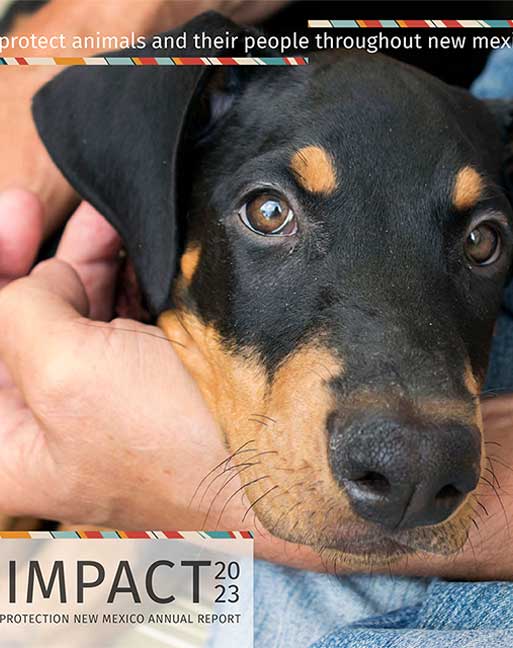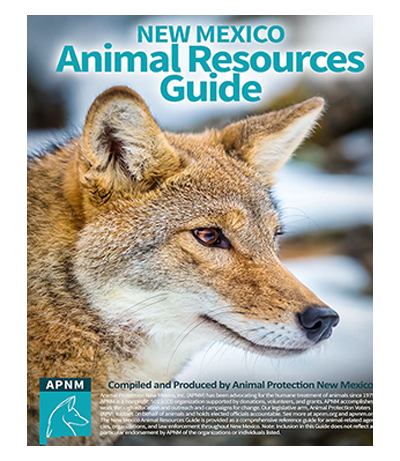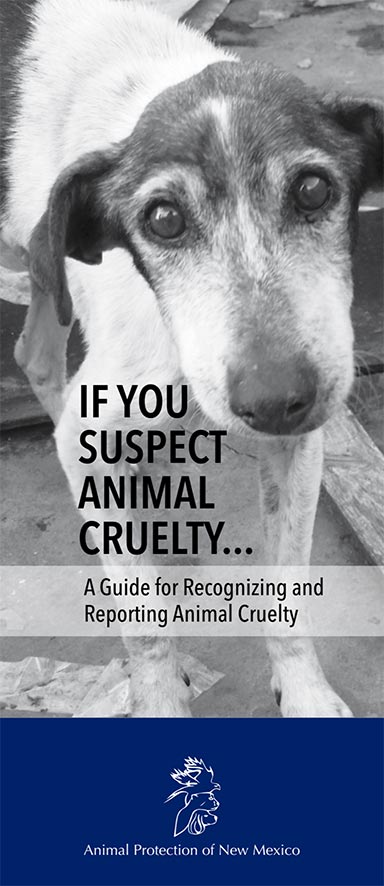We can all make a difference in the investigation and prosecution of animal cruelty cases. In New Mexico there are a limited number of animal control officers, sheriff’s deputies and others charged with enforcing animal cruelty laws. They are often charged with enforcing these laws over large geographic areas of the state, and the time they can allocate to animal cases is often limited. Therefore, citizens who can observe and report abuse or neglect are vital to protecting both the wild and domesticated animals in New Mexico. Below are some considerations and suggestions for use by anyone who may observe an animal in distress.

[541 KB PDF]
Animal cruelty cases deserve major attention in their own right. But in addition, numerous studies show a direct correlation between abuse of animals and the potential for future violence against people, including domestic violence. Animal abuse is frequently a first step toward future criminality. Serial murderers such as Ted Bundy and Jeffrey Dahmer began their violent behavior by first hurting and later killing animals.
Finally, if you witness animal abuse caused by a young person, it is just as important to report as such abuse by an adult, and perhaps even more crucial. Early intervention can help children who abuse animals avoid such behavior in the future. Abuse of animals within the home is often tied to domestic violence. Adults who abuse children or other household members frequently hurt animals in the home as a threat or warning to the other members of the household. The circle of violence can be perpetuated when children and other victims of abuse hurt animals.
Observation
What you observe during your normal daily activities is key. Consider what you see as you walk or drive around your neighborhood. Most reported cases are based upon observations of neighbors.
Signs of Neglect
Some people think that abuse or neglect exists only when they see an animal who is injured, but broken limbs or oozing wounds are not the only indicators of abuse. Animals deserve to live in humane conditions. Abuse and neglect can take many forms. Something as simple as an animal being out in the sun with no possibility of shade from our hot summer heat can be neglect. An animal left without water for eight hours while a person goes to work can also be neglect.
Look for the following things as potential signs of neglect:
- lack of adequate food, total lack of food, obvious malnourishment
- lack of sufficient shelter from sun or heat
- exposure to extreme cold, rain, snow, etc.
- lack of sufficient water
- insect or other bites
- untreated skin sores, such as caused by rubbing of harnesses, ropes or anything used to restrain an animal
- any signs of untreated injuries
- signs of fighting injuries
Document Your Observations in Detail
If you observe what you believe to be abuse or neglect, it is important for you to document your observations. If the conditions later lead to a case, your documentation can prove vital to successful prosecution.
Begin by taking good notes. Be sure to document all the important facts and include as much detail as you can. There is no such thing as too much detail. But lack of detail and specifics can cause problems for the possible prosecution of a case. Experienced investigators often use a voice recorder to capture detailed descriptions while driving. Most smart phones built-in have voice recorders, and voice-to-text apps are available to easily convert your notes to a written form.
The most basic information you should gather is:
Who
Who is at the scene? Who can confirm what you have seen? You need the names of all the people who may have witnessed anything related to the animal about whom you are concerned. This includes the owners of the animal or anyone else you know has seen things. It would also include the names of any police officers or animal control officers you speak with about the case.
What
Write down in detail what you see that you believe to be abuse. Be particularly thorough about documenting injuries. Describe any injuries in detail, noting their size, color and location on the animal. Note how long you think the injuries may have been present.
Documenting the animal’s living conditions is also crucial. Note whether the animal has shelter (and if so, what kind), food, water, and what the area surrounding the animal looks like. Note if there is excessive filth, excrement, droppings, trash, dangerous materials or substances in the animal’s living area.
When
Note the date and time of day you make your observations. Be specific about the weather conditions. Record whether it is snowing, raining, hot, cold, etc. If possible, note the actual temperature.
Where
Write down the exact address of the animal’s location. Also specify the place on the property where the animal is located, i.e. the front yard, back yard, alley, barn, porch, etc. If it’s in a rural location, note road names, cross streets, landmarks, etc. Your vehicle or smart phone’s GPS feature can provide exact coordinates.
Why
Describe what you believe to be a violation of the law. Also state how you happened to be there and made your observations.
How
Write down everything that you did at the scene. If you observe actions of others at the scene, write those down, as well. Capture the details such as:
- who you spoke to
- what they said
- what you saw
- the detailed condition of the animal
Make notes regarding the attitude of the animal. Is he/she afraid, friendly, shaking, aggressive, etc. Also note how the animal reacts to the “owner”.
Keep all the notes you make for future reference. Don’t discard them. You may see a sign of abuse and then nothing else for several months. Then you may see abuse again. It helps to have your notes to establish a pattern of abuse if one develops over time. CAUTION: Never surrender your original notes or photographs to anyone, even law enforcement. Things can get lost. Always make copies of your notes and photos, and only turn over copies to others.
Photographs and Video
It is a truism that a picture is worth a thousand words. This is especially true if a case goes to a jury. Being able to see the actual scene and condition of the animal is the best evidence. Photographs do a good job of convincing a judge or jury of the animal’s true condition, and video can be even more compelling, especially in cases of a person actively abusing an animal.
Photos and videos also help avoid the problem of “he said”/”she said”. They give an actual image to show what the problem is and leave little open to interpretation. Smart phones have a built-in camera that captures photos and video, so use it to document the conditions that you see. Such a video would be very valuable as evidence in a court case. It is best if you can take photographs of things in “plain view”, such as from a public location like a public road or sidewalk. The term “plain view” means anything that you can see from a public vantage point.
In the law there is also a term “exigent circumstances”. In the context of animal cases, this means that if an animal is in peril of imminent death, you can intervene to save the life of the animal. One example would be an animal hanging by the neck from a chain and choking. If you do not release the animal, he/she will choke to death. Saving an animal in that circumstance would not affect the viability of the case.
Be aware that if police or other law enforcement officials enter private property without a warrant, they may not be able to use any evidence they find. So if they enter barns, private lands, houses, etc. and seize evidence without a warrant, such evidence may be suppressed and the case could be spoiled. Your information and evidence can help law enforcement officials get a warrant.
CAUTION: In your pursuit of a case, you do not trespass or break any other laws. If you break the law, people could question your testimony. Your credibility will be an issue if the case actually goes to court.
Reporting the Abuse/Neglect
Once you have your documentation ready, call your local animal control officer, police, sheriff, or whoever has jurisdiction in the area of the abuse. Know where the abuse is located and who has jurisdiction (i.e. municipal animal control, county animal control, county sheriff, state police, etc.). Try to have your case handled by local law enforcement in your community. You should be a witness, not an enforcer.
Note: If the conditions are extreme, do not wait to document. Call for local law enforcement help immediately.
Other Important Considerations
If in your investigation you find dead animals, make every effort to get a local veterinarian to come to the scene and see the animals and the surroundings in which they expired. If the death was caused by neglect or abuse, proving the cause of death can be very important. Contact animal control or your local shelter to find out how to get a necropsy (animal autopsy) done. This is the ultimate way to prove cause of death. It would be important to be able to establish the cause of death in a criminal case.
Resources and Help
If you have questions on a case, contact Animal Protection New Mexico, Inc., your local animal control department or an animal-friendly prosecutor. Prosecutors who handle animal cases and have experience in proving them in a court of law can be an invaluable resource to you.
If you have a serious case, try to get advice as early as possible. Waiting to seek advice can mean the loss of valuable evidence. Also consult APNM’s Animal Resources Guide for information.
Remember: the goal is to help save and protect animals from harm.





